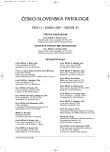Correlation Among Clinical and Morphological Findings in a Diffuse Axonal Injury
Authors:
P. Toupalík 1; P. Klír 2; H. Marková 3; J. Ježková 2
Authors‘ workplace:
Ústav soudního lékařství 2. LF UK, Praha
1; Subkatedra soudního lékařství IPVZ, Praha
2; Radiodiagnostická klinika 3. LF UK a FNKV, Praha
3
Published in:
Soud Lék., 52, 2007, No. 2, p. 31-34
Overview
In a man of 56 years – a victim of traffic accident, contusions in both temporal lobes of the brain and a small subdural and subarachnoid haemorrhage were diagnosed by CT and MR examination. According to the findings of petechial haemorrhages in the corpus callosum a diffuse axonal injury was clinically diagnosed. After 2 months the patient died. Excisions of corpus callosum and the brain-stem were examined by histological staining including Palmgren@s method and by immunohistochemical detection of neuron-specific enolase (NSE) in damaged axons.
Clinical findings were compared with morphological findings, i.e. autopsy, histological and immunohistochemical examination. The possibilities of clinical diagnostics of diffuse axonal injury are discussed.
Key words:
diffuse axonal injury – immunohistochemistry – neuron-specific enolase
Labels
Anatomical pathology Forensic medical examiner ToxicologyArticle was published in
Forensic Medicine

2007 Issue 2
Most read in this issue
- Correlation Among Clinical and Morphological Findings in a Diffuse Axonal Injury
- The image analysis of colour changes of different human tissues in the relation to the age. Part 1. Methodological approach
